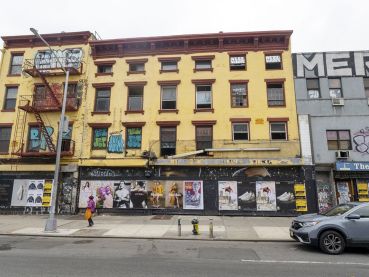Federal Program Aims to Jump-Start Secondary ‘Tech Hubs’
Up to $10 billion could roll out to areas with tech specializations, sparking new leasing and development
By Logan Nagel July 28, 2023 7:00 am
reprints
It might not be “Squid Game,” but the federal government’s place-based economic development competitions have regions fighting to win funds nonetheless.
In May, the U.S. Economic Development Administration (EDA) began accepting applications for the Regional Technology and Innovation Hubs program and its $10 billion of authorized, though not yet fully available, funding. The Tech Hubs program is meant to identify regions — likely areas that would be considered secondary or tertiary real estate markets — that demonstrate the potential for growing into “globally competitive” tech centers within the next 10 years.
The EDA is targeting semiconductor manufacturing, robotics and biotechnology among other likely areas of investment.
With $500 million already funded, the program’s first phase will designate 20 or more regional consortia comprised of economic development agencies, government entities, educational institutions and other stakeholders as Tech Hubs. Designation will allow these consortia to apply for an expected $50 million to $75 million implementation award in the second phase of the program.
Consortia will also be able to apply for strategy development grants, which will award each region’s lead organization approximately $400,000 to $500,000 to be used pursuing Tech Hub designation in the future, or Phase 2 implementation awards if their consortium secures designation this round.
The program follows the Build Back Better Regional Challenge, which last year awarded $1 billion in grants to 21 coalitions around the country under a similar regional development goal. New York won two awards, including $25 million for its advanced manufacturing cluster in the western part of the state, while southwest Pennsylvania secured $62.7 million to help build a cluster focused on robotics and autonomy.
There are two pieces necessary to transform a region into a tech cluster, according to Creighton Armstrong, a senior managing director for government services with JLL (JLL). It starts with education to develop a workforce for companies to hire. “I really think it’s driven around the university, with the opportunities available and the employees that a company can hire,” Armstrong said. “If you’re a company looking to relocate from one part of the country to another, that’s a big part of what you’re looking to achieve.”
The second piece is securing one big name to act as a growth magnet. Armstrong pointed to the development of a massive semiconductor plant near Phoenix as one example, where manufacturing firm TSMC has a huge development just outside the city.
“They put their stake in the ground and now their suppliers are coming,” he said. “You want to create these regional hubs where you get good interaction between the suppliers and the main company that’s going to inspire and potentially start new companies and new innovation. But it has to be done in a thoughtful way, where you aren’t pricing out the suppliers.”
The TSMC project is expected to secure billions of dollars of incentives from the federal government under the CHIPS Act semiconductor manufacturing incentive. The Tech Hubs program, while smaller in terms of available funding than CHIPS, will apply to a more diverse range of industries. By spurring development in markets that are “on the edge of glory,” regions that were until now dormant may see an explosion of activity, Alejandra Castillo, assistant secretary of commerce for economic development, told tech news site technical.ly.
Depending on the size of the funding secured, that activity could play out over different scales.
“It’s hard to see Build Back Better prompting a major transformation in all regions, but it could happen in some, and clearly in the immediate vicinity of activity there could be neighborhood or central business district or tech center activity,” said Mark Muro, senior fellow at the Brookings Institution. Meanwhile, he said, the “Tech Hubs regions, to the extent that they are built out and fully funded, which they are not now, could be that kind of transformative investment.”
This is where commercial real estate professionals get involved.
Programs like Tech Hubs present an opportunity for local brokers already within these sidelined markets, as well as a chance for brokers from big cities to expand their businesses, according to Ben Shapiro, a New York-based vice chairman with Newmark. “New York City is still supply-constrained. I think brokers understand that, and the good ones are going to understand how to succeed in that market, but if there’s business to be done for a semiconductor research plant in Buffalo, we’re going to go where we can help our clients perform the best.”
Much of the real estate activity resulting from these incentive programs could be flex industrial space, Shapiro said. “We’re seeing a lot of demand for ‘maker space’ and lab space, whether it’s dry lab [laboratory space focusing on computers as opposed to potentially hazardous chemicals] or traditional lab space.”
Economic development agencies, like those that coordinate bids for place-based economic development programs, gain a lot from collaborating with real estate firms because of their local expertise.
That was the case for Ben Pratt, the regional economic competitiveness officer at the Allegheny Conference for Community Development, one of the organizations that recently helped Pennsylvania secure its $62.7 million of Build Back Better funding. The funds will go to five projects aimed at improving robotics and autonomy skills and commercialization opportunities in the area, including $12 million for an accelerator called the Robotics Startup Factory and $6.9 million to help underrepresented groups launch careers in these industries.
Pratt’s organization works directly with real estate partners, including one large firm he was unable to disclose. He said the primary benefit is getting access to important market intelligence, as well as an unbiased comparative view of the strengths and weaknesses of the region, using the skills and data-based approaches of the real estate community.
“We are working with commercial real estate firms and independent speculative developers who are giving us a better understanding of vacancy rates, existing leases, and triple nets for the industry clusters,” he said.
The Tech Hubs program specifically requires applicant teams to include a variety of different organizations, and that’s very deliberate. Even the best brokers, university leaders, and economic development professionals are incapable of galvanizing a region into a new economic engine alone. “It’s going to take the government, the private sector, the brokerage community and academia being involved, and when you look at how these regional tech hubs have formed it’s usually a strong government lead and a strong economic development agency that wants to attract and retain companies to their areas, but its also going to take a strong labor force that will be driven by academia,” Armstrong said.
Applications for Phase 1 designations and strategy development grants are due on Aug. 15, and recipients will be announced this fall. Those who secure designation will then have the opportunity to apply for the much larger Phase 2 implementation grants as well. For the commercial real estate brokers who may be salivating at the prospect of those funds and the resulting investment coming to their markets, there’s good news. The best thing they can do to help out is simply do what they do best: talk.
“Having that candid conversation with commercial real estate firms that can validate based off their own client experience is incredibly valuable,” Pratt said. “I would argue the best regional economic development agencies are the ones that have engaged the commercial real estate firms with the most candid discussions.”


